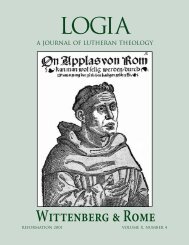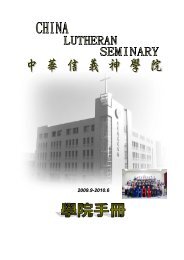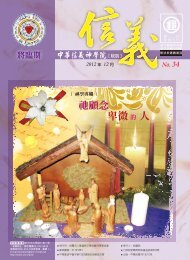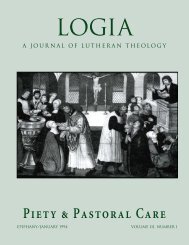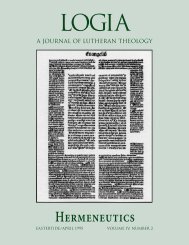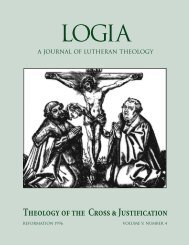You also want an ePaper? Increase the reach of your titles
YUMPU automatically turns print PDFs into web optimized ePapers that Google loves.
called & ordained 23<br />
and the other offices, which do appear later but often very early,<br />
are foreshadowed in the community of the new Israel which<br />
Jesus gathered about him. Nothing is more central to the New<br />
Testament depiction of Jesus than that he was pre-eminently<br />
the “sent-one” from the Father—he is even termed an “apostle”<br />
in Heb 3:1—who with full authority speaks and acts for the<br />
Father. This perfect apostleship of Jesus is indicated often in<br />
the Gospels, for example in that Johannine-sounding statement<br />
of Jesus recorded in Mt 11:27: “All things have been delivered<br />
to me by my Father; and no one knows the Son except the<br />
Father, and no one knows the Father except the Son and anyone<br />
to whom the Son chooses to reveal him.” Also those passages<br />
of John’s Gospel where Jesus says that he speaks nothing<br />
from himself but only that which the Father has given him to<br />
say, and that he does nothing but that which the Father has<br />
given him to do present Jesus as the perfect apostle, the one<br />
sent from the Father. Jesus, for example, said: “He who believes<br />
in me believes not in me but in him who sent me, and he who<br />
sees me sees him who sent me.... For I have not spoken on my<br />
own authority; the Father who sent me has Himself given me<br />
commandment what to say and what to speak. ... What I say,<br />
therefore, I say as the Father has bidden me” (Jn 12:44-50). Of<br />
course, it is clear in John’s Gospel that Christ is not only the<br />
speaker of God’s words but is himself the Word of God. Christ<br />
is himself the Torah of God, so that he is the prophet greater<br />
than Moses: “<strong>The</strong> law was given through Moses, but grace and<br />
truth came through Jesus Christ” (Jn 1:17). Yet, in passages<br />
such as this, and perhaps most especially in the story of his<br />
baptism, it is clear that Christ is the “chosen one of God” who<br />
preaches the kingdom which he himself brings and who<br />
through that preaching gathers around himself a new congregation<br />
of the end time. As Harald Riesenfeld has noted, Jesus<br />
“was the first to bear office in the new people of God.” 7<br />
In fact, titles and representations of Jesus such as “Messiah”<br />
and “Son of Man” are indissolubly linked with the idea of<br />
the “kingdom of God” and the “people of God.” And with the<br />
ideas of the kingdom of God and the people of God the<br />
Gospels open up a perspective on Jesus’ ministry which<br />
stretches through the long history of Israel. As Israel through<br />
Moses had become God’s “kingdom of priests” and his “holy<br />
nation” because God had chosen them, had given them a<br />
promise of inheritance, had given them the Law by which to<br />
remain faithful, and had led them through his chosen representatives,<br />
so now in Christ, God was calling a renewed people<br />
of the kingdom, granting to them the promise of the inheritance<br />
of sons, giving to them a new way of life which is the way<br />
of Christ’s cross, and leading them through his <strong>Holy</strong> Spirit.<br />
Jesus is himself the new center of the renewed people of God,<br />
and in the gathering of the twelve disciples about Jesus there is<br />
represented not only the reconstitution of the people of God<br />
who were first founded upon the twelve patriarchs but there is<br />
also represented the perfect fullness of the redeemed people of<br />
God who are no longer dispersed but gathered. 8<br />
Harald Riesenfeld has called attention to the organic<br />
metaphors and images which Jesus used to indicate and to<br />
denote the kingdom he brings. 9 <strong>The</strong>se metaphors imply that<br />
Jesus does not exist as one person among the people of God,<br />
but that he is in the midst of the disciples he gathers about<br />
himself as the source and defining focus of their life together as<br />
disciples. <strong>The</strong> image of the vine and the branches is illustrative<br />
(Jn 15:1 V.): “<strong>The</strong> tree or the stem and the branches are for one<br />
another, and otherwise would have no reason to exist. Nevertheless,<br />
it is plain that the tree is at the same time the source of<br />
life, ‘for without me ye can do nothing’ (Jn 15:5).” 10 <strong>The</strong> vine<br />
does not exist alone, nor do the branches exist alone. Yet, they<br />
do not relate to one another as mutually coordinate entities.<br />
<strong>The</strong> branches are not independent and do not give fruit from<br />
themselves and on their own. <strong>The</strong>y are given their life and their<br />
task through the vine so that what they have received from the<br />
vine they can pass on as the fruits of their receiving. In this<br />
sense the branches are dependent on the vine and are ordered<br />
to the vine, and in this sense the vine may be said to be prior to<br />
the branches. Only in their being bound to the vine are the<br />
branches a part of the plant. I think Riesenfeld is correct when<br />
he concludes that in their New Testament context the use of<br />
such metaphors as the vine and the branches “involved, to<br />
some extent, an argument from its structure and function.” 11<br />
<strong>The</strong> function of giving and of receiving denotes a structure and<br />
configuration which fundamentally orders the reality and life<br />
of God’s people as his church. That configuration is one of<br />
Christ and his disciples, of the vine and the branches, of the<br />
pastor and the people. <strong>The</strong> church entails and embraces both.<br />
As Ignatius of Antioch put it, for a true unity “you cannot have<br />
a head without members” (Trall. 11:2). We might add, for a<br />
true unity neither can you have members without a head.<br />
Jesus is himself the new center of the<br />
renewed people of God, and in the<br />
gathering of the twelve disciples about<br />
Jesus there is represented not only the<br />
reconstitution of the people of God<br />
who were first founded upon the<br />
twelve patriarchs but there is also<br />
represented the perfect fullness of the<br />
redeemed people of God who are no<br />
longer dispersed but gathered.<br />
Other metaphors used by Jesus also function to indicate<br />
both the intimate unity between Jesus and his followers as well<br />
as the role he plays in their midst. In a strong eschatological<br />
context Jesus speaks of the householder who “leaves home and<br />
puts his servants in charge, each with his work” (Mk 13:34). In<br />
the parallel passages of Matthew and Luke, Jesus speaks of the<br />
master who sets his “wise and faithful” servant over his household<br />
“to give them their food at the proper time” (Mt 24:45; Lk<br />
12:42). It is legitimate to perceive in texts such as these, statements<br />
of Jesus in which he is alluding, not to the totality of his<br />
followers, but to those who are given the service of oversight<br />
within the community of believers. <strong>The</strong> reference in Mark to






